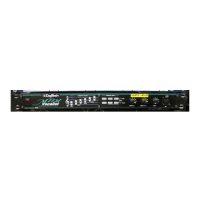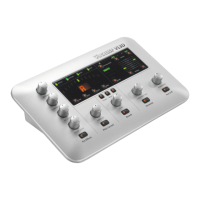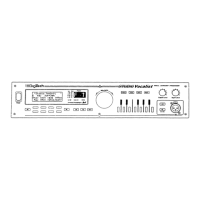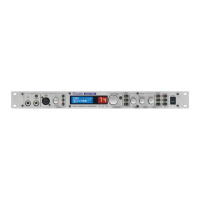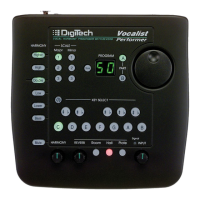Do you have a question about the DigiTech VOCALIST II and is the answer not in the manual?
| Brand | DigiTech |
|---|---|
| Model | VOCALIST II |
| Category | Computer Hardware |
| Language | English |
Describes the capabilities and functionalities of the Vocalist II unit, including harmonies, effects, and MIDI implementation.
Details the technical parameters such as S/N, THD, Sampling Rate, Bandwidth, and Input/Output specifications.
Details the functions of buttons, knobs, LEDs, and displays on the front panel of the Vocalist II.
Describes all input and output jacks and connectors on the rear panel of the Vocalist II.
Generates diatonically correct harmonies based on chosen key and scale type for each sung note.
Generates harmonies that fit over individual chords, relative to the selected chord and root.
Allows the Vocalist II to recognize chords played on a MIDI keyboard to generate appropriate harmonies.
Introduces pitch and volume modulation effects that can be added to generated harmonies.
Adds subtle pitch variations to harmonies, creating a chorus effect for a fuller sound.
Enables storing chord changes for up to 50 songs, allowing sequential playback via footswitch or MIDI.
Processes sung notes based on pitches played on a MIDI keyboard, creating synthesized vocal effects.
Describes various pitch manipulation effects for creating unique vocal textures.
Corrects the pitch of the sung note to match specific pitches played on a MIDI keyboard.
Guides on connecting microphones, line sources, and external effects to the Vocalist II.
Instructions for setting Input, Vocal, and Harmony levels using the front panel controls.
Tips for ensuring optimal microphone signal strength and avoiding noise for better harmonization.
Explains how to navigate and use the Vocalist II's parameter and menu system for editing.
Presents a collection of programs showcasing various harmony types and effects.
Highlights programs featuring chorus, detune, and pitch shift effects.
Describes programs utilizing the vocoder function for synthesized vocal harmonies.
Explains programs that generate harmonies fitting over specific chords, with various voicings.
Allows adjustment of the basic tuning reference, typically set to A = 440 Hz.
Enables singing in the note that generates harmonies, useful during harmony editing.
Adjusts the display contrast for optimal visibility, with settings from 0 (low) to 3 (high).
Displays the current version number of the Vocalist II software.
Configures MIDI settings for controlling and being controlled by external MIDI devices.
Fine-tunes the unit's sensitivity to sibilant sounds for improved harmony quality.
Reduces microphone feedback by adjusting the sensitivity of the harmony generation.
Resets all editable programs to their original factory settings, erasing custom changes.
Defines how the footswitch bypass function operates (latching, momentary off, momentary on).
Sets the initial key and chord type for a selected program, affecting subsequent harmonies.
Allows individual harmony voices within a program to be turned on or off.
Adjusts the pitch of harmonies slightly to create a chorus effect, enhancing vocal thickness.
Controls the output volume for individual harmony parts sent to the left and right channels.
Adds controlled pitch oscillation (vibrato) to the generated harmonies for a more natural sound.
Introduces slight, random out-of-tuneness to harmonies for a more human vocal quality.
Controls the speed of sliding between pitches for harmony notes, adding a vocal-like quality.
Selects the type of harmony generation (Chromatic, Scalic, Chordal, Vocoder, Pitch Correct).
Defines the relative position of harmony notes to the input note, specifying intervals for Scalic or Chordal harmonies.
Configures the vocoder for Mono (1 voice), Doubled (2 voices), or Normal (4 voices) output based on MIDI input.
Enables MIDI Pitch Bend control to shift harmony notes up or down by a specified number of semitones.
Shifts harmony notes up or down by octaves relative to the MIDI keyboard input, or uses auto-octave selection.
Allows defining a specific range on a MIDI keyboard for controlling Vocalist II harmonies, enabling separate left/right hand functions.
Adjusts the pitch of sung notes to match specific MIDI notes, offering monophonic harmony.
Allows naming and customizing program titles using up to 16 characters.
Sets the key for Scalic programs or the root for Chordal programs, and selects the scale or chord type.
Explains how to save edited harmonies to the current or a new program number.
Describes the feature for presetting program and chord changes for entire songs.
Explains how songs are divided into sections, each with its own chord and program changes.
Details the information shown in the song list display, including song name, program, and chord.
Sets the time signature (3/4 or 4/4) for each section of a song.
Interface for entering and editing chord and program changes for specific steps within a section.
Allows programming count-in beats for the introductory part of a song.
Provides functionality to edit the title of a song, allowing up to 16 characters.
Configures song selection using MIDI song select commands from external devices.
Allows advancing through song steps using the footswitch.
Enables automatic song sequencing synchronized with MIDI clock signals from external devices.
Synchronizes song playback with a drum machine via MIDI, initiated by the footswitch.
Provides a step-by-step guide for programming a song list, using "Pretty Woman" as an example.
Details entering program and chord data for the Intro section, including bypass and section end markers.
Describes programming chord and program changes for the first part of a song's verse.
Details programming for the second part of a song's verse, including section end.
Explains entering chord and program data for the chorus section of a song.
Describes programming chord and program changes for the bridge section of a song.
Details programming for the song's ending section, including final chord and section end.
Guides on using MIDI foot-sync mode for automatic song sequencing with drum machines.
Explains how to use MIDI Full-Auto mode for automatic song playback synchronized with drum machines.
Explains scale types (Chromatic, Major, Minor, Wholetone, Diminished) and keys used for Scalic harmony.
Defines chord types and roots, and explains how harmony notes are chosen relative to chords.
Controls the width of pitch oscillation for vibrato effect in harmonies.
Adjusts the quickness of pitch oscillation for vibrato effect in harmonies.
Sets the time delay before vibrato effect starts after a new note is sung.
Controls the speed of sliding between pitches for harmony notes, adding a vocal-like quality.
Instructions for connecting MIDI keyboards, sequencers, and other devices to the Vocalist II.
Explains how to select Vocalist II programs using MIDI Program Change messages.
Defines musical octave and its relation to note numbering within the Vocalist II.
Refers to adjustable elements of programs and utilities accessed via control buttons.
Describes using MIDI pitch bend controllers to alter harmony note pitch.
Explains the function of adjusting sung notes to match specific MIDI pitches.
Defines the sliding effect between pitches for harmony notes.
Identifies the fundamental note of a scale, crucial for Scalic harmony selection.
Indicates when the microphone signal is clear enough for the Vocalist II to harmonize.
Describes the process of saving edited parameters and programs to memory.
Accesses global parameters affecting all programs, with changes automatically stored.
Refers to the DigiTech Vocalist II 5-voice Vocal Harmony Machine.
Explains vibrato as a controlled oscillation of pitch and volume in harmonies.
Describes the vocoder's ability to control harmony notes via MIDI and its configurations.
Defines how harmony note positions relative to the input note are specified for Scalic or Chordal harmonies.

